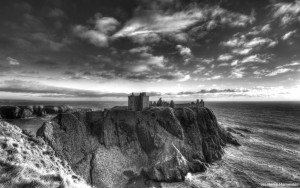Dunnottar Castle
Dunnotar Castle is located on a rocky hill, about 3km south of Stonehaven, Scotland. Most of the buildings are largely of the 15th–16th centuries and the castle played an important role in the scottish history, because you can overlook the shipping lanes to northern Scotland.
The lobster catcher
The lobster fishing is a large fishing industry. The lobster traps are either rectangular-shaped or half-cylinders, made from oak and surrounded by a rope mesh. Normally, the lobster traps are sunk to the ocean bottom with weights, are baited with dead fish and are connected to each other with a rope.
Dunnottar Castle in Black & White
This photo was taken on an early November morning about two miles (3 km) south of Stonehaven. Dunnottar Castle is a ruined fortress located upon a rocky headland and the surviving buildings are largely of the 15th – 16th centuries. The castle plaid an important role in the history of Scotland, because of the location: it overlooked the shipping lanes to northern Scotland and on the opposite it controlled land access to the coastal south.
In the present-day, the castle was the venue of the movie “Hamlet” with Mel Gibson and Glenn Close.
Sunrise at Dunnottar Castle
Dunnottar Castle is located on a rocky hill, about 3km south of Stonehaven, Scotland. Most of the buildings are largely of the 15th–16th centuries. The castle played an important role in the scottish history, because you can overlook the shipping lanes to northern Scotland.
Stonehaven
Stonehaven lies on Scotland’s northeast coast and grew around an Iron Age fishing village.

